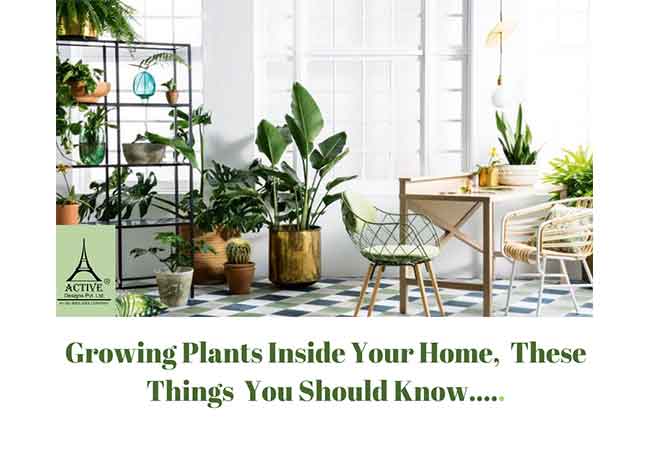
Growing Plants Inside Your Home, These Things You Should Know…...
Are you used green plants only for ornamenting your outdoors? If you like you can fill your living spaces with a natural green colour. For this indoor plants is the best way to get green in your home. However, the point to be considered is that these indoor plants must get more care than the plants in outdoor. It should be in the form of nutrients which are not excessive but available to the nutrients needed for storage. You can bring plants inside as there is a lack of outdoor areas, or can used to purify the indoor air or can use as the ornamental décor to give more stunning looks to your interiors. Whatsoever your reason for indoor gardening in your home there might be many challenges that you will face to correctly nurturing your indoor plants. Following are some of the problems faced by growing indoor plants and the things you should know for properly nurturing your indoor plants:
- Too Much or Too Little Light
Commonly, the problem faced by indoor plants is the availability of enough light. This is due to when plants growing in the space where there is too little light, it will lead to turning pale and certain stretches for the indoor plants. So these kinds of plants may advantage by being relocated to a west or south window or have enough light complemented with artificial light. On the other hand, plants getting too much light or sun shades may lead to turning a yellowish colour and may occur tan or certain white patches on the leaves of plants in the positions with straight exposure to the sun. So before you begin growing plants in indoors, you will require to comprehend the connexion between plants and light. Every plant needs light; most of the plants need direct sunlight, however, the degree of light of each plant varies.
- Watering Plants
Proper watering is crucial to growing plants inside. It’s quite normal that one forgets to water a plant and it turns out to be too wilts and dry. In these things, death often happens because the plant becomes crisp or it begins to initiate a slower weakening from that the plant can never recover, only when we properly watering the plants. In certain circumstances, roots might have died and succeeding watering simply leads to the dead roots rot. Eventually, drought and rot killed the indoor plant.
Watering an excessive amount of may result in plant disease, and plants grown in the pots might be damaged. So make sure to place plants in pots only with proper drain holes. It is also advisable to place the pots on a drain saucer to collect excess water after you water. Watering indoor plants isn't similar to watering plants that are on your terrace, balcony or outdoors. There are certain queries raised when growing plants in indoors, they are:
• How much sunny streams into the place where the plants are kept?
• What will be the indoor temperature?
• What will be the container size?
• Is there steady air flow or cross ventilation is inside the house?
To decide on a watering schedule supported the answers to these queries. Plants will do with excess water if they take sufficient daylight for 3 to 4 hours. If the inside temperature is very high then watering the plants at regular intervals is necessary. Tiny containers can want regulated watering. Plants in an exceeding area with solid air flow can be watered little liberally. So it’s best to pick containers rigorously. Make sure that they have correct drainage holes, thus excess water if any will drain out.
- Lack of Nutrients
Whether you notice the leaves of plants begins to fade? This may because of the lack of nutrients. The main nutrients needed for plants are nitrogen, phosphorus and potassium. Plants want more than just sunlight and water for its survival. They also needed a nutrient-rich soil. However, it is not suggested that you need to overload the soil with a large amount of fertiliser. Surplus fertiliser can burn the roots of the plants and can eventually destroy it. Also, it should be noted that chemical fertilisers are not good for indoor plants. As they will discharge poisons into the air, which is dangerous to the inmates. So it is preferred that adding compost to the soil is good for indoor plants and inmates since it is the organic fertilizer.
- Dealing With Humidity, Cold, Heat and Moisture
All plants vary in the intake of moisture, heat, humidity and cold. Indoor plants are bare to the inside climate which can be controlled as per the preference of human. We use heat convectors in winter and AC in the summer season to control indoor temperatures. Though, air-conditioning units and warmth convectors drastically change the humidness. The indoor temperature conjointly becomes either too heat or too cold for plants and may have associated adverse result on indoor plants. The plants may not survive underneath such extreme conditions. Methods to handle this downside is to cluster plants along and either use a humidifier to manage the wetness within the air or by artificial means produce humidness, by spraying a fine mist of water over and around the plants, throughout the day.
Are you looking for the right interior designers to organize your interiors with the right kind of indoor plants with the right place? For this, you need to find out the best interior designers in Kochi with the jiff of elegance and creativity. So to build your best solutions you can catch Active Designs the best home decorator Cochin for designing your dream home will definitely let you an astonishing experience for your interior decoration desires. We will pursue your dream home with unique design and innovative technologies in the best possible methods.